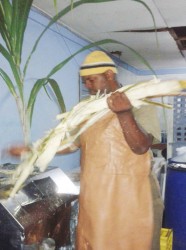This weekend, Gordon Lashley and his wife Carol are taking their cane juice mill and their entrepreneurial optimism to the Providence Stadium where they hope that the first ever staging of the Guyana Festival might provide some measure of breakthrough for a beverage which, as much as any other, can be considered ‘local drink’.
The Lashleys are banking on the marketing thrust of the organisers of the event who have been presenting it to the public as a ‘must go’ event for locals and visitors to Guyana alike.
What the Lashleys are also hoping is that the Festival, which opens later today will help to popularize his modest fifteen-year-old cane juice enterprise.
Cane juice is no stranger to the local beverage market. The problem is that it has never been able to take itself ‘off the corner’. To present itself as more than a ‘wash down’ or an on the corner thirst-quencher. Meanwhile the old-fashioned aerated drinks have become transformed by their plastic disposable bottles and their multi-million dollar advertising budgets.

The fast food franchises and the fresh fruit drink vendors have also upped their, ‘throwing in’ modern dispensers, disposable cups and health-related tips to seize a substantial slice of an enduringly thirsty market,
The Lashleys have tried at GuyExpo though they admit that success has not gone beyond short-term spikes in demand on account of event sales,
At the Guyana Festival the Lashleys hope to sell more than just a few bottles out of their refrigerated truck. They will be doing demonstrations with their cane juice mill imported from Brazil and hoping that they might be able to ‘tie up’ at least a few supply contracts for G&C’s Natural Juices. The Guyana Festival, hopefully, will provide another opportunity to try to restore cane juice to the local beverage ‘map.’
That is where cane juice had been for centuries. Sugar cane might have been a major colonial economic empire but the greenish liquid has been put to other purposes and cane juice is one of them, though the vending of the juice has not been really successful in taking itself off the streets here in Guyana. That, it would seem, is the Lashleys’ objective: to get their bottled juice far more entrenched in the mainstream market, to ‘ease up’ on pounding the streets to sell the product.
Gordon Lashley understands the market and knows that there is probably no overwhelming demand for cane juice at what one might call their ‘high end’ of the market. That has to be cultivated.
Last Tuesday we found Gordon and Carol and their mill and their huge bundle of sugar cane at their customary location, inside the same compound housing the East La Penitence Post Office.
That is the nerve centre of the business though Gordon concedes that targeting a broader clientele would require him to raise his own game, to look more closely at offering enhanced environmental guarantees, That is one of his immediate-term goals.
Prior to being in the Post Office Compound, the facility was situated on America Street, a decidedly better location for the cane juice business, From that vantage point they sold around 200 gallons of cane juice per week, These days it’s down to around 70 gallons,
Things have changed. There is no cane juice market to speak of where the mill is now located so the Lashleys cling tenaciously to their remaining mainstream clients – Juice Power, Shanta’s and a handful of other snackettes and restaurants.
Almost certainly, some of their customers have been lost to the fruit juice craze. Gordon has even gone to Bartica to take a look at the market there. It used to be good but sales have slipped in recent months and like most other businesses he blames gold prices.
A 16-ounce bottle of G&C’s cane juice will set you back $200. That is competitive when compared with the same volume of fruit juice offered by a downtown fast food establishment. It is, however, twice the price of the same amount of cold water sold on the streets these days. Perhaps not surprisingly, the Lashleys extol what they say are the health virtues of cane juice. On the streets the Lashleys favour Rasville as a “good area” for selling cane juice. The production process, the juicing of the cane, takes place in East La Penitence. Bottling takes place at the same site. The juice is stored in the refrigerated truck prior to delivery. The truck was acquired on hire purchase at a cost of $4.3 million.
Canes are purchased from private cane farmers mostly on the West Bank Demerara. The current price is $10,000 per tonne. He says that he has developed an excellent relationship with the farmers over the years.
The Lashleys are hopeful that the Guyana Festival might help to ‘turn things around’ for his enterprise. He has seen and heard the hype about likely visitor arrivals and of the marketing that has been done to get the locals to Providence. Their own economic fortunes would appear to be inextricably bound up with those of the Festival.




